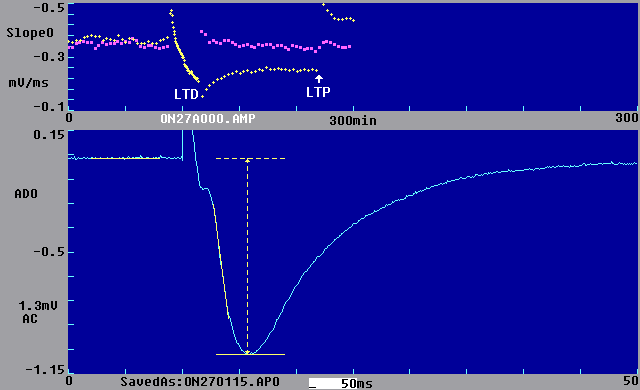LTP Program
Version 2.4
William W. Anderson
Preprint of Journal of Neuroscience Methods paper
Papers using the LTP Program or WinLTP

LTP Program Version 2.4 William W. Anderson
Preprint of Journal of Neuroscience Methods paper Papers using the LTP Program or WinLTP |
 |
WinLTP can reanalyze all LTP 2.4 files. Because WinLTP is easier to use and has more reanalysis capabilities, WinLTP should now be used for LTP 2.4 file reanalysis. The one exception is analysis of dual trains (which you can do in WinLTP by analyzing twice).
Because WinLTP uses inexpensive National Instruments M-Series PCI boards, it is also probably more cost effective to use WinLTP than LTP 2.4 for online acquistion (plus it does a lot more!).
The LTP Program is a stimulation, data acquisition and on-line analysis program for studying Long-Term Potentiation (LTP), Long-term Depression (LTD), and related phenomena. For a general description of the LTP Program capabilities, see Preprint of Journal of Neuroscience Methods paper. Click here to read the on-line LTP manual. For a free copy of the LTP Program you must agree to the CONDITIONS for using the LTP Program, REGISTER, and then DOWNLOAD the program (2.4).
The DOS LTP Program runs on ISA bus computers and uses the inexpensive multichannel Measurement Computing's CIO-DAS08/JR-AO board ($250/£150) and on the Pico Technology's ADC-42 board ($150/£100), in addition to the Axon Instruments' Digidata 1200 board and the Scientific Solutions' Labmaster board.
If you have any questions please contact WinLTP support at: [email protected].
This is the last DOS version of the LTP Program (except for bug fixes and minor enhancements).
| LTP Program functionality |
| 1. | The LTP Program records synaptic activity in extracellular, intracellular or patch clamp modes | |
| 2. | ||
| 3. | Repetitive sweeps with simultaneous data acquisition (up to 1,000,000 samples in 2 AD channels on a 64 MB machine at 100 usec intervals) and stimulation (using two extracellular pathway stimulation, S0 and/or S1, and epoch-like digital and intracellular analog stimulation) | |
| 4. | Basic protocols are either slow single pathway S0 stimulation, or slow alternating dual pathway (S0 then S1) stimulation | |
| 5. | Analyze all S0- and S1-evoked postsynaptic responses in both AD channels in a sweep |
|
| 6. | On and off-line calculation and plotting of several waveform parameters: DC baseline, Peak Amplitude, Peak Latency, Slope, Area, Duration, 10-90% Rise Time, 10-90% Decay Time, Coastline, PopSpike Amplitude, PopSpike Latency, Average Amplitude, Cell resistance (Rm), and Patch electrode series resistance (Rs) | |
| 7. |
Special analyses of trains including: Analyze all peaks in a train relative to the baseline of the first pulse |
|
| 8. |
Automatic blanking of stimulus artifacts to allow accurate determination of peaks and areas in a train |
|
| 9. | The sweep data can be signal averaged and digitally filtered on- and off-line | |
| 10. | Reanalysis of general ASCII sweep files, plus utility the programs atf2swps.exe (to convert of Axon Text Files (*.ATF) to many single sweep ASCII files), and dv2swps.exe (to convert a multisweep ASCII file exported by DataView to many single sweep ASCII files). | |
| 11. | LTP induction can be produced by: Single train, repetitive train (theta burst stimulation), and primed burst stimulation | |
| 12. | LTD stimulation and analysis can be performed using fast repetitive sweeps (at up to 2 Hz), or a single sweep lasting several minutes for faster repetitive stimulation | |
| 13. | ||
| 14. | Plotting of ADsweep and Amplitude graphs on HP LaserJet printers |
|
LTP Program requirements |
| 1. | Computers using DOS 6.x / Windows 3.x or Windows 95/98 (it can also run on Windows ME and Windows NT/2000/XP computers) | |
| 2. | 16-64 MB of memory | |
| 3. | Data acquisition board (Axon Instruments' Digidata 1200, Scientific Solutions' Labmaster, Pico Technology's ADC-42 and Measurement Computing's CIO-DAS08/JR-AO) |
Updated April 24, 2012.